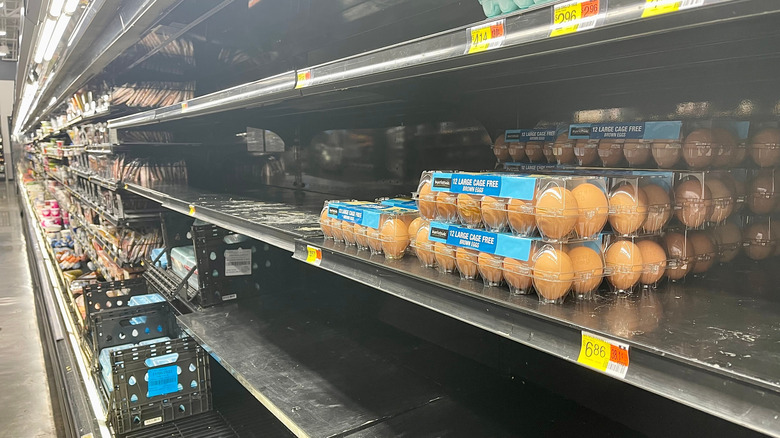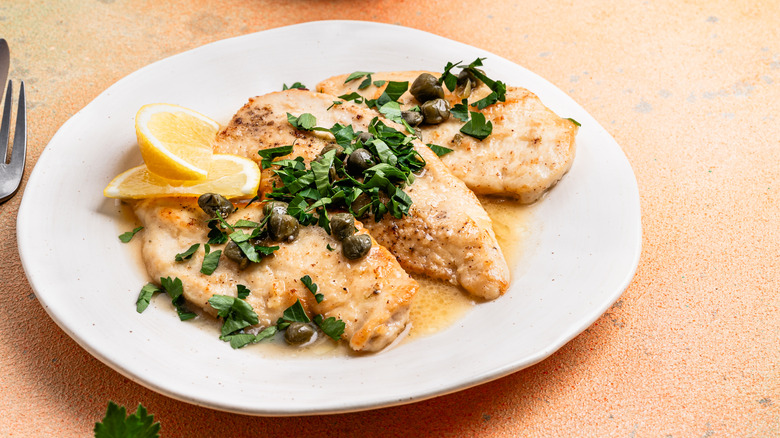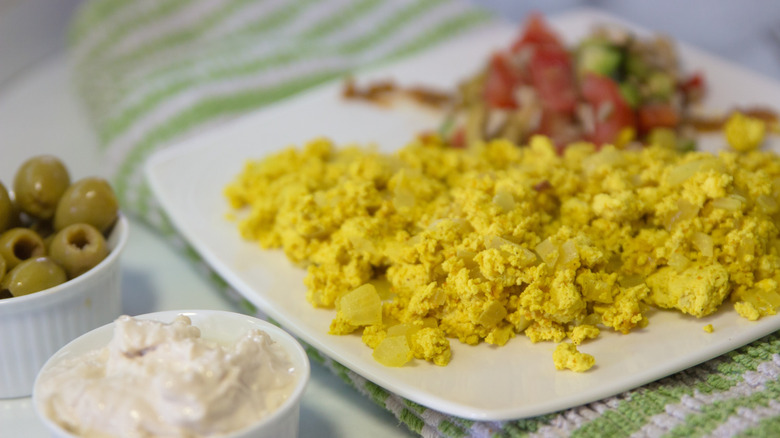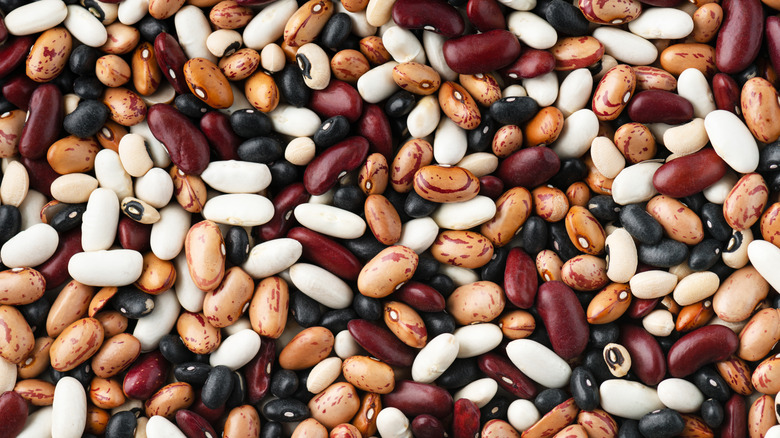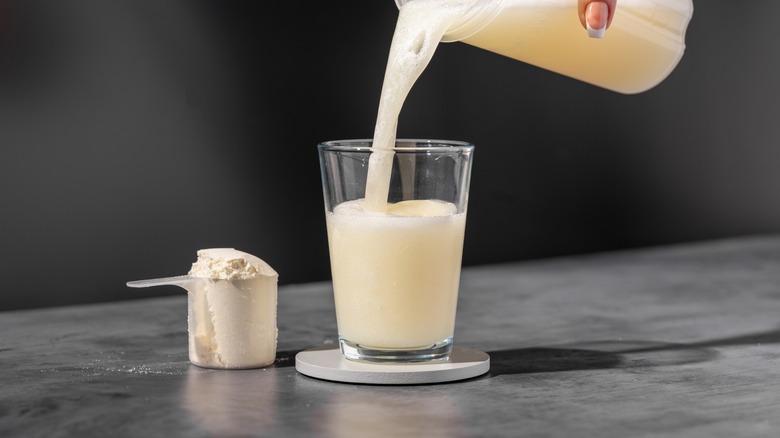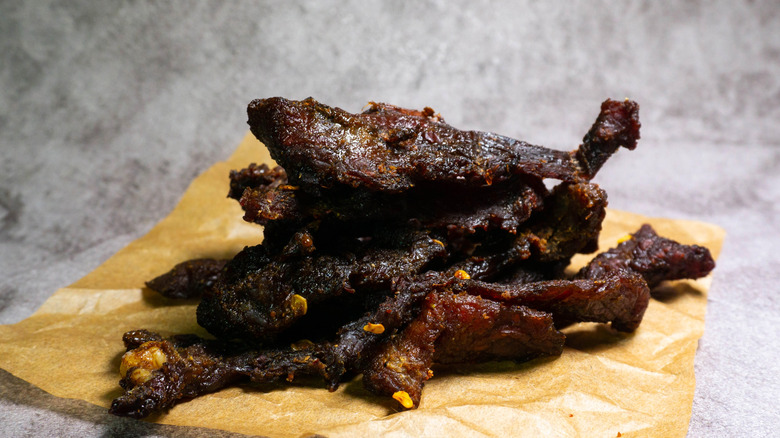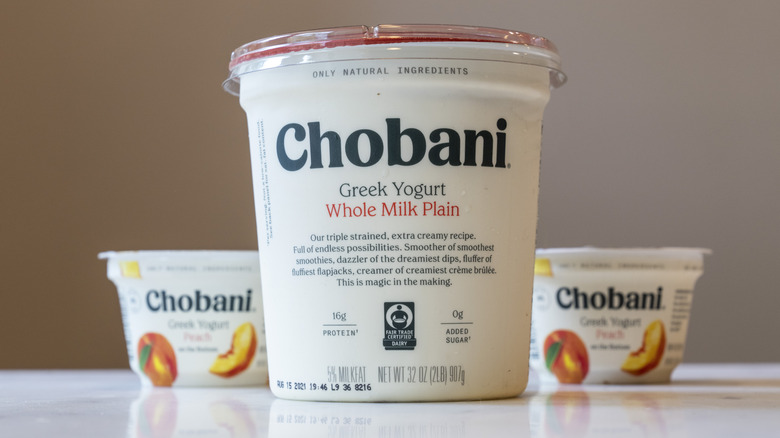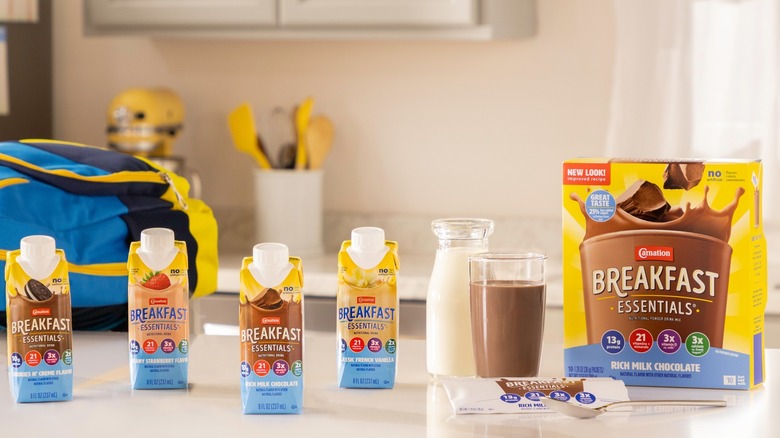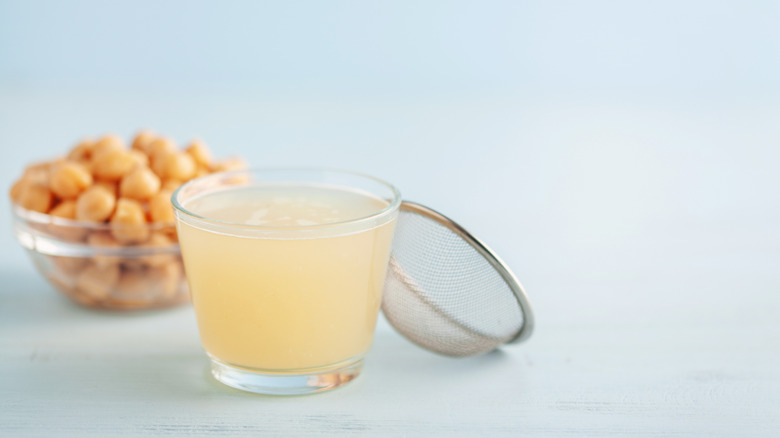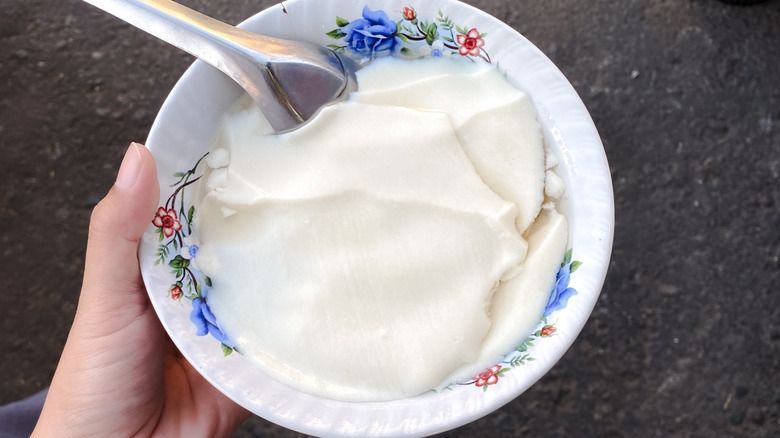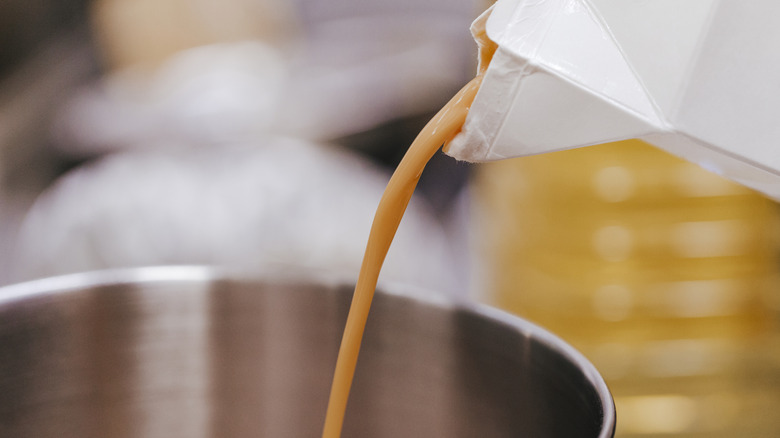High-Protein Egg Substitutes Experts Recommend During The Shortage
We may receive a commission on purchases made from links.
When you think of the most basic items you might pick up on a grocery store run, milk, bread, and eggs may jump to mind. They're basically a given to grace most shopping carts at least a few times a month. But what happens when one of those items becomes difficult to find? Egg-loving households are finding out, but even as some grapple with price increases and low supply, there's really no need to stress. There are plenty of ways to replace this high-protein food in your diet. From replacements solely made for baking to others that may just become your new scramble, you'll find that the grocery store has plenty of options.
If you rely on the protein from eggs to help fulfill your protein needs, there are plenty of protein-rich foods that are well suited for the task. Whether it is breakfast, lunch, snack, or dinner time, protein swaps abound. We reached out to experts to discover some of their recommendations during this egg shortage. Experts Destini Moody, a certified dietician and nutritionist from Top Nutrition Coaching, and Danielle Michael, Nutrition Services Director with Encompass Health of Nittany Valley, shared their expertise on eggs and getting protein into your everyday diet, even within the shortage.
Before you go shopping, be sure to check the catacombs in the back of your pantry; you may have some options tucked away, just awaiting their time to shine. Other than protein substitutes, there are direct substitutes for those eggs. Some alternatives might seem a little unorthodox, but getting creative in the kitchen leads to some of the most eggs-traordinary outcomes (sorry).
Get your protein from chicken and seafood
In the midst of an egg shortage, Destini Moody asks, "Why not go to the source and turn to chicken?" Chicken is easy to incorporate in breakfast, lunch, or dinner, and the best part is that, per serving, chicken actually contains double the protein you get in eggs. When trying to decide which cuts of chicken you might buy, consider going for a whole bird. Spatchcocking is the way to go to ensure you achieve an even cook. After using what you need, you can always hang on to the rest for easy leftover chicken, ideal for quick breakfasts or lunches. If you're accustomed to egg salad sandwiches for lunch, consider using your leftovers to make shredded chicken for chicken salad sandwiches.
No need to restrict yourself to poultry, though. As Moody explains, both "Poultry and seafood like chicken and fish are low in saturated fats and provide high-quality amino acids just like eggs do." In fact, salmon has three times the amount of protein as eggs. So, in terms of protein swaps, you're winning big with this meal change. Not to mention, if chicken salad isn't your taste, perhaps tuna salad would work better. This swap has the benefit of using a product that's canned and easy to prepare.
Swap scrambled eggs with a tofu scramble
With the egg shortage, you might see the amount of scrambled eggs you end up making scaled back. But if this is a fixation breakfast for you, consider swapping out scrambled eggs for tofu scramble. Destini Moody explains that "For our plant-based friends, tofu scrambles in the morning with a bit of turmeric make an excellent substitute." The turmeric is mostly there to add some yellowish color and make the scramble look more like typical scrambled eggs. Though tofu scramble is a favorite of vegans, this swap is something anyone would enjoy.
Tofu scramble is great because there are as many ways to dress it up as there are different additions you can make to scrambled eggs. Liven it up with salsa, cheese, and sour cream (if you're not vegan) to really trick your brain into thinking you've whipped up some scrambled eggs. Once you've dipped your toe into the tofu world, don't be shy about including it in other ways. Danielle Michael states that "Tofu is a great substitute to get protein at any meal of the day." She recommends frying it in a pan and then adding sauce and even veggies for a stir-fry.
Integrate beans and lentils for protein and fiber
In the world of plant-based protein options, tofu isn't the only easy-to-integrate option. Destini Moody reminds us that "legumes like beans and lentils provide some protein along with a great source of fiber." And though your first thought might be bean salad and chili, there are lots of ways to add extra protein to nearly every meal with this simple ingredient.
If your tofu scramble needs even more protein, supercharge it with some black beans. Those same beans can even be made into desserts, like brownies or even ice cream. Of course, the most viral way to add beans to your diet is with a dense bean salad. For these, you combine a bunch of ingredients (beans, unsurprisingly, among them) into a big bowl and keep it in your fridge for lunch throughout the week. Not only will you have lunch ready all week, but that meal will be hearty and rich in protein to help power you through the remainder of the day.
Lentils may be newer to your diet, but if you want a protein-packed food, you should be cooking with lentils. In fact, a cup of lentils has 18 grams of protein. For a first meal playing with lentils, we find that soups go especially well, like spiced coconut lentil soup, a dish sure to please vegans and omnivores alike.
Drink your protein with milks
To substitute your protein intake of an egg through your beverages, you'll be looking for drinks that get close to the protein content of an egg. Destini Moody recommends cow's milk or soy milk because they "are rich sources of protein with all of the essential amino acids." Regardless of the type of cow's milk you choose (skim, 2%, or whole), the protein content per serving is the same at 8 grams. Soy milk has a little less protein at 7 grams. However, even the largest eggs only go up to about 8 grams of protein per egg, so either milk is, comparatively, a protein-rich option.
If you'd prefer a different plant-based milk, the numbers dip a little, but are still commendable. For instance, Elmhurst pistachio milk has 3 grams per serving, and you could froth it up for use in your coffee. To keep a supply in your pantry, Amazon sells the barista blend in packs of six. Oatly also offers a barista edition oat milk with 3 grams of protein, also ideal for your daily latte. Cashew milk is an even richer protein option, with homemade versions consisting of about 5 grams of protein.
Step up your protein game with whey protein isolate
If milks just don't offer enough protein, and you are steadfast on drinking your protein to replace any protein loss from egg shortages, Destini Moody has a drinkable solution. She shares, "Whey protein isolate is my personal favorite choice to blend into a beverage or smoothie any time of the day." While there are plenty of whey protein powders out there, not all are whey protein isolate.
Whey powder is a product that comes from making cheese. After the curds are removed, the leftover whey is turned into powder, and whey isolate is a processed version of this whey. Rather than including all the fat and lactose, it becomes mostly just protein.
Protein smoothies are a solid option to jump-start your day with a drinkable breakfast, but they also make a fantastic on-the-go lunch. Whey powder mixed with a protein-rich milk, fruit for flavor and sweetness, and your other favorite additions make for a filling way to get that protein in.
Find protein in your snack choices
To compensate for protein you may be missing out on from eggs, consider finding places to add protein in your daily snacking. Destini Moody recommends "fitting protein into snacks in the form of whole foods (rather than protein bars), like string cheese, Greek yogurt, and jerky."
Choosing these protein-rich snack foods rather than a protein bar is an immediate change anyone can make. Protein bars, on the other hand, tend to be something of an acquired taste. We've noticed that these bars tend to boast indicators like "now better tasting" or "improved flavor." These little notices, though they promise something better, are red flags. Go for something that always tastes good, like cheese or jerky. Frigo's cheese sticks will get you 5 grams of protein per stick. Golden Island's Korean Barbecue jerky has 7 grams per serving or 20 grams for the whole bag. And if we're being honest, whoever only ate a few pieces of jerky? You'll be temped by the whole bag.
To dive headfirst into fresh, protein-rich snack territory, consider making your own homemade beef jerky. Setting out on your own to season the jerky well may feel like too big of a leap. In that case, you might choose a jerky making kit to ensure well-seasoned bites.
Amp up dips with protein swaps
Protein doesn't need to be a designated main course or even snack. Sometimes, there are ways to better integrate it into what you're already doing. Dips are a great example of how seamlessly protein can find its way into your day-to-day or even shared dish at a gathering. Danielle Michael recommends using "plain Greek yogurt instead of sour cream to make dressings and dips."
Sour cream and Greek yogurt tend to have fairly significant differences in taste, but when used in place of sour cream, your dip's other elements will do a nice job of covering up the difference in flavor. Even two ingredient dips have enough different flavors that the swap is really more for consistency than anything else. But you could take this swap even further and simply use Greek yogurt instead of sour cream anywhere it is used, provided the sour cream is not an essential flavor of the dish.
The protein gained from this kind of switch is substantial. Chobani's plain nonfat Greek yogurt, for instance, has 16 grams of protein per serving. Daisy sour cream, on the other hand, has 1 gram of protein. Granted, the serving size of Daisy is 2 tablespoons compared to Chobani's ⅔ cup, but since there are just over 10 tablespoons in ⅔ cup, that still would put Daisy at 10 grams of protein compared to Chobani's 16 grams if you had the same amount of each.
Skip from scratch pancakes for protein-rich ones
If your family enjoys pancakes, this is another place to bring more protein to your diet. Danielle Michael recommends trying out protein pancakes. Consider checking out Kodiak Cakes Power Cakes, which have 14 grams per serving. Plus, since Kodiak Cakes only need water or milk to prepare, you won't need to dip into your egg supply to make these pancakes. Unfortunately, that's not the case with all protein pancake mixes, so if you're looking to preserve eggs, be sure to check preparation instructions before committing.
Just as there are some pancakes that need eggs, there are other pancakes that bring more protein. Bulk Cakes makes a mix that also just combines with water and piles on the protein at 21 grams. Depending on your nutritional needs, that may be too much protein, so be sure to shop around for that Goldilocks zone for yourself.
Find fast protein in a Carnation Instant Breakfast
Breakfast tends to be a meal on the go for many people, and if you fall into that category, there are drinkable, protein-packed breakfasts you can try. Danielle Michael likes Carnation Breakfast Essentials. These nutritional drinks come in chocolate, strawberry, and vanilla flavors.
When prepared, the chocolate and strawberry breakfast powders have 13 grams of protein, and the vanilla flavor has 18 grams. Need it to also be a coffee drink? You could always experiment with coffee additions for a caffeine boost. Carnation also offers ready-to-drink options. However, these ready-to-drink options curiously have less protein. The chocolate drink has just 10 grams of protein, three less grams than the powder. It might not seem like a large drop in protein, but at just over a third of the total protein, it could be substantial enough to offset the convenience of a ready-to-drink option.
Use aquafaba to replace emulsified eggs
Preparing canned beans, you're most likely accustomed to draining off the liquid. Hopefully, we caught you before you drained your can of chickpeas while preparing that batch of hummus. That's right: It's time to stop throwing our your chickpea water and use it as an egg substitute.
This liquid is called aquafaba, and, according to Danielle Michael, "Adding aquafaba into recipes as an emulsifier is a great way to increase protein. It can be used in soups, sauces, or even marinades." Admittedly, the amount of protein in aquafaba is minimal (a little less than a gram) and significantly less than the chickpeas themselves, but you can also replace flour with chickpeas for ridiculously rich chocolate cake, so the whole can is used up.
As an emulsifier, where you may normally use eggs, aquafaba is the perfect swap. If you've gotten accustomed to smothering homemade mayo on your turkey sandwich lunch, you'll be happy to know that aquafaba is a key ingredient to making it possible to make mayo without eggs. No need to sacrifice this sandwich upgrade just because you don't have the eggs to spare.
Replace eggs with silken tofu in baked goods
There are several different types of tofu, and if you're new to the cube-shaped bean curd, it may be a little confusing. The differences revolve around how much liquid is in each type and what the texture is like. Extra-firm tofu is a style you'll typically use in recipes like stir-fry, salads, or pastas, but silken tofu is quite a bit different from regular tofu.
Silken tofu's texture is closer to a custard that can hold its jiggly form. We like it as a protein boost in smoothies or dips, like you might use Greek yogurt, but that's not the only thing it can do. Destini Moody tells us that "Silken tofu can be used in place of eggs in baked recipes, which is a known trick among our vegan friends." For this protein-packed substitute for eggs, you'll blend up that silken tofu very well. Once it forms a paste-like consistency, measure out ¼ cup for each egg needed. The best part is that if eggs were the only meat or dairy product you were needing for your recipe, it's now safe for all of your vegan friends to enjoy, too.
Save time with liquid eggs
Of course, when substituting eggs, you could always go for eggs that are already in liquid form. Destini Moody shares that "Any recipe that requires beaten eggs, such as scrambles or baked goods, is great for egg substitutes as the liquid form saves you a ton of time (and dishes)." Plus, liquid eggs tend to cost quite a bit less. In a time when egg prices are a matter of political heat and lightened wallets, anything to earn a little savings is surely appreciated. Plus, if you choose to make this swap in your kitchen, you'll be in good company. Bodegas around the Big Apple have been making the switch over to liquid eggs to help pass savings on to customers.
Depending on pricing in your grocery store, you can purchase a 20 serving carton of egg beaters for $7.43. These liquid eggs are ready to go right out of the jug, so you don't even need to worry about cracking shells for your dish. Alternatively, Just Egg makes liquid eggs that are vegan and act nearly exactly like other liquid egg mixtures. One serving of Just Egg has 5 grams of protein, so it's relatively similar in protein content to a typical egg. For something that keeps longer in your pantry, consider the opposite of liquid eggs: dry eggs. These won't be the most ideal for all situations, but for scrambled eggs, they're perfect.

